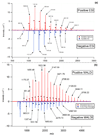Dual polarity accurate mass calibration for electrospray ionization and matrix-assisted laser desorption/ionization mass spectrometry using maltooligosaccharides
- PMID: 18655765
- PMCID: PMC3410823
- DOI: 10.1016/j.ab.2008.06.041
Dual polarity accurate mass calibration for electrospray ionization and matrix-assisted laser desorption/ionization mass spectrometry using maltooligosaccharides
Abstract
In view of the fact that memory effects associated with instrument calibration hinder the use of many mass-to-charge (m/z) ratios and tuning standards, identification of robust, comprehensive, inexpensive, and memory-free calibration standards is of particular interest to the mass spectrometry community. Glucose and its isomers are known to have a residue mass of 162.05282Da; therefore, both linear and branched forms of polyhexose oligosaccharides possess well-defined masses, making them ideal candidates for mass calibration. Using a wide range of maltooligosaccharides (MOSs) derived from commercially available beers, ions with m/z ratios from approximately 500 to 2500Da or more have been observed using Fourier transform ion cyclotron resonance mass spectrometry (FT-ICR-MS) and time-of-flight mass spectrometry (TOF-MS). The MOS mixtures were further characterized using infrared multiphoton dissociation (IRMPD) and nano-liquid chromatography/mass spectrometry (nano-LC/MS). In addition to providing well-defined series of positive and negative calibrant ions using either electrospray ionization (ESI) or matrix-assisted laser desorption/ionization (MALDI), the MOSs are not encumbered by memory effects and, thus, are well-suited mass calibration and instrument tuning standards for carbohydrate analysis.
Figures






References
-
- Lawrence DL. Accurate mass measurement of positive ions produced by ammonia chemical ionization. Rapid Commun. Mass Spectrom. 1990;4:546–549.
-
- Jonscher KR, Yates JR., III Mixture analysis using a quadrupole mass filter/quadrupole ion trap mass spectrometer. Anal. Chem. 1996;68:659–667. - PubMed
-
- Jiang L, Moini M. Ultramark 1621 as a reference compound for positive and negative ion fast-atom bombardment high-resolution mass spectrometry. J. Am. Soc. Mass Spectrom. 1992;3:842–846. - PubMed
-
- Lattimer RP. Fast atom bombardment mass spectrometry of polyglycols. Int. J. Mass Spectrom. Ion Proc. 1984;55:221–232.
-
- Goad LJ, Prescott MC, Rose ME. Poly(ethyleneglyol) as a calibrant and solvent for fast atom bombardment mass spectrometry: application to carbohydrates. Org. Mass Spectrom. 1984;19:101–104.
Publication types
MeSH terms
Substances
Grants and funding
LinkOut - more resources
Full Text Sources
Other Literature Sources

